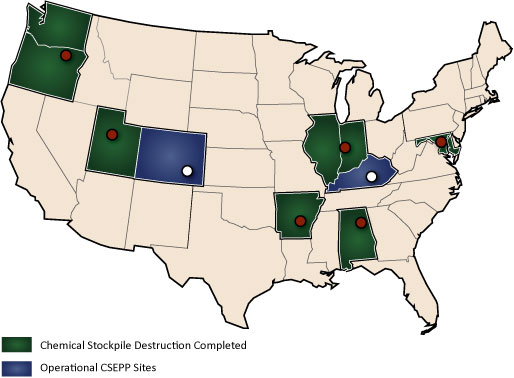What is CSEPP
Overview
CSEPP Purpose
CSEPP is a unique Whole Community partnership whose participants share a common goal: to prepare and enable communities to protect residents in the unlikely event of a chemical emergency at one of the Army’s chemical stockpile sites. CSEPP’s vision is “a fully prepared team of local, installation, tribal nation, State, and Federal professionals, developing and executing an effective emergency preparedness and response program.”
To fulfill this vision, CSEPP’s mission is “to enhance existing local, installation, tribal, State, and Federal capabilities to protect the health and safety of the public, workforce, and environment from the effects of a chemical accident or incident involving the Department of the Army chemical stockpile.”
CSEPP Statute
In 1985, Congress (see DOD Authorization Act, 1986, Public Law 99-145) directed the Department of Defense (DOD) to dispose of its chemical agents and munitions while providing “maximum protection for the environment, the general public, and the personnel involved.” FEMA joined the Army in implementing CSEPP through a Memorandum of Understanding originally signed in August 1988 and most recently updated in March 2004. FEMA provides financial and technical support to State and local officials under a Cooperative Agreement with the State. FEMA support to the surrounding community continues until the Army completes the destruction of the associated installation’s stockpile.

CSEPP was created to address the risk posed by the U.S. stockpile of chemical weapons. The Army-produced video "Fog of War" provides a history of chemical warfare, a review of the Chemical Weapons Convention and the elimination of the U.S. stockpile, and the role of CSEPP in this process.
CSEPP Sites
CSEPP began with eight chemical stockpile sites throughout the country. By 2014, six of the eight chemical stockpile sites have completed destruction of their chemical stockpiles (shown as green on the map below). Only two chemical stockpile sites remain in Bluegrass, Kentucky and Pueblo, Colorado (shown as blue).

Sites that have completed destruction of their chemical stockpiles:
- Anniston Chemical Activity, located on Anniston Army Depot (Alabama)
- Deseret Chemical Depot (Utah)
- Edgewood Chemical Activity, located on Aberdeen Proving Grounds (Maryland)
- Newport Chemical Depot, (Indiana and Illinois)
- Pine Bluff Chemical Activity, located on Pine Bluff Arsenal (Arkansas)
- Umatilla Chemical Depot (Oregon and Washington)
Remaining chemical stockpile sites:
- Blue Grass Chemical Activity, located on Blue Grass Army Depot (Richmond, Kentucky)
- Pueblo Chemical Depot (Pueblo, Colorado)
See more about CSEPP Sites
CSEPP History
 FEMA began providing preparedness assistance to communities near chemical stockpile sites in August 1988 through an agreement with the Army. Under this agreement, the Army provides for protection of personnel at its chemical depots (on-post) and provides funding to FEMA to assist State and local governments to carry out functions related to emergency preparedness and response in the communities surrounding depots (off-post).
FEMA began providing preparedness assistance to communities near chemical stockpile sites in August 1988 through an agreement with the Army. Under this agreement, the Army provides for protection of personnel at its chemical depots (on-post) and provides funding to FEMA to assist State and local governments to carry out functions related to emergency preparedness and response in the communities surrounding depots (off-post).
This enhanced the abilities of the civilian communities neighboring the eight original CSEPP sites to respond to potential chemical warfare agent emergencies. The agreement also established a framework for partnering with potentially affected State, local, and tribal governments to provide for public health and safety; identify roles and responsibilities; and establish joint program efforts in planning, training, exercising, and exchanging information. The agreement has been reaffirmed and revised over the years as the program matured; a 1997 revision (reaffirmed in 2004) gave FEMA responsibility and accountability for all aspects of off-post emergency preparedness.
See More CSEPP History
Additional Resources
2023 CSEPP Report to Congress
FY 2019 CSEPP Report to Congress describes the actions taken to assist State and local governments in protecting the health and safety of the public, workforce, and environment from the effects of a chemical accident or incident involving the U.S. Army chemical stockpile.
CSEPP Program Guidance
The CSEPP Program Guidance provides guidance and best practices for implementing the program as described in the CSEPP Strategic Plan. The content is organized by the 12 CSEPP National Benchmarks and contains new graphics to illustrate concepts and increase readability. The guide also includes references to important planning initiatives, such as assessment tools; community profiles; the threat and hazard identification and risk assessment process; and planning, organizing, equipping, training, and exercising.
CSEPP Strategic Plan
CSEPP Strategic Plan
reflects a coordinated, joint effort between the Department of the Army and the Department of Homeland Security (DHS), Federal Emergency Management Agency (FEMA) to develop and manage a Chemical Stockpile Emergency Preparedness Program (CSEPP).
CSEPP Legacy Brochure
CSEPP Legacy Brochure provides an overview of the program’s innovations in protective action decision-making, training, exercises, medical preparedness, public outreach, and program measurement.
CSEPP Factsheet
CSEPP Factsheet provides a snapshot of the current status of the program.
CSEPP Brochure
CSEPP Brochure provides a historical overview of the CSEPP mission and the eight original U.S. Army chemical stockpile locations.
CSEPP Alignment Overview
CSEPP core capability and ERO alignment.
CSEPP Alignment
Alignment of emergency response outcomes with core capabilities by mission areas.
CSEPP Core Capabilities
CSEPP national benchmarks, national preparedness system components, and national preparedness goal core capability alignment.

